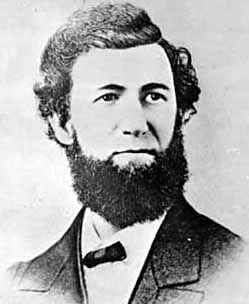Benjamin Hanby
Benjamin Hanby | |
|---|---|
 |


Benjamin Russell (or Russel)[1] Hanby (July 22, 1833 – March 16, 1867) was an American composer, educator, pastor, and abolitionist. He is known for composing approximately 80 songs and hymns, most notably "Darling Nelly Gray" and the Christmas songs "Up on the Housetop", and "Jolly Old Saint Nicholas".[citation needed]
Life and legacy
[edit]Hanby was born in Rushville, Ohio, on July 22, 1833.[2] In 1849, he moved to Westerville to enroll at Otterbein University,[3] and was later involved in the Underground Railroad with his father Bishop William Hanby.[citation needed]
In 1856, at what is now the national historic site the Hanby House,[4] Hanby composed the popular anti-slavery ballad "Darling Nelly Gray",[5] based on his encounter with Joseph Selby, a runaway slave from Kentucky who had died in the Hanbys' Rushville home.[6] Hanby went on to write several other notable anti-slavery songs, including "Ole Shady", "The Song of the Contraband", and "Little Tillie's Grave".[7]
After graduating in 1858, Hanby briefly taught school before becoming a minister in the Church of the United Brethren in Christ. In 1860, he became the principal of Seven Mile Academy in Seven Mile, Ohio.[citation needed]
By Christmas of 1864, after some time as a minister in a church in New Paris, Ohio, Hanby was operating a singing school in the town.[5] Here, he composed "Up On The Housetop" as a Christmas sing-along, originally titled "Santa Claus". In 1865, Chicago-based publisher George Frederick Root published the song and brought Hanby to Chicago to pursue other ventures.[citation needed]
On March 16, 1867, Hanby died in Chicago from tuberculosis at the age of 33.[5] He is buried in Otterbein Cemetery in Westerville. Today, the Hanby House is a museum managed by the Westerville Historical Society.[citation needed]
References
[edit]- ^ "Benjamin Russel Hanby, Ohio Composer-Educator, 1833–1867 (1987)" in C. B. Galbreath, Song Writers of Ohio, in 14 Ohio Archaeological and Historical Publications 180 (1905).
- ^ Benjamin Hanby at Ohio History Central
- ^ William Osborne, Music in Ohio 421 (2004); Galbreath, supra, at 183.
- ^ "Hanby, Benjamin, House (added 1970 - - #70000493)". National Register of Historic Places.
- ^ a b c ""Benjamin Russel Hanby", Hanby House". Archived from the original on 2015-04-12. Retrieved 2015-04-30.
- ^ "Benjamin Hanby and His Anti-Slavery Song". Westerville Public Library. Archived from the original on January 28, 2022. Retrieved February 10, 2022.
- ^ "The Civil War in Sheet Music". Ohio History Connection. Retrieved February 10, 2022.[permanent dead link]
External links
[edit]- Benjamin Hanby at britannica.com
- Benjamin Hanby at ohiohistorycentral.org
- Hanby House information from the General Commission on Archives and History
- Free scores by Benjamin Hanby at the International Music Score Library Project (IMSLP)
- Benjamin Hanby at Find a Grave
- Ohio Archaeological and Historical Quarterly, p. 180, at Google Books
- Hanby House Museum
- American male composers
- Otterbein University alumni
- 1833 births
- 1867 deaths
- People from Fairfield County, Ohio
- 19th-century deaths from tuberculosis
- Musicians from Dayton, Ohio
- People from Westerville, Ohio
- American United Brethren in Christ
- American abolitionists
- Tuberculosis deaths in Illinois
- Ministers of the Evangelical United Brethren Church
- 19th-century American composers
- People from New Paris, Ohio
- 19th-century American male musicians
- American school principals
